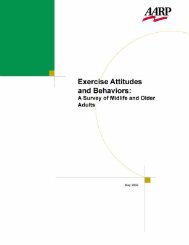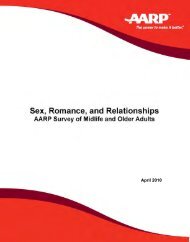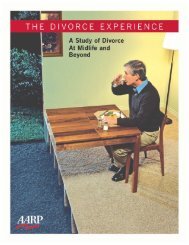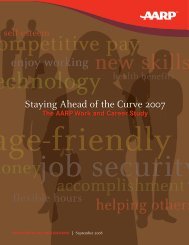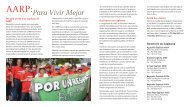The New Aging Enterprise - aarp
The New Aging Enterprise - aarp
The New Aging Enterprise - aarp
Create successful ePaper yourself
Turn your PDF publications into a flip-book with our unique Google optimized e-Paper software.
Retirement Housing<br />
Where will tomorrow’s older population live? <strong>The</strong> answer that Americans give,<br />
overwhelmingly, is to remain in their own homes. <strong>The</strong> image of senior citizens moving to a golf<br />
retirement community in Florida or Arizona may be a popular stereotype, but it is far from the<br />
truth. At the point of retirement, only 10% of people move from their homes and, of that<br />
number, only half will even move across state lines. Nonetheless, retirement communities are<br />
important elements as we try to plan for “Livable Communities” for an aging population. Dating<br />
back to the development of Sun City, retirement communities have attracted only a small<br />
proportion of older people. <strong>The</strong>y have had influence in shaping the way we think of the meaning<br />
of later life and the housing that reflects that understanding. In this section, we examine one<br />
instance of a new type of retirement community that is quite different from the Sun City model<br />
pioneered a generation ago. We also consider other innovative forms such as “naturally<br />
occurring retirement communities” and senior cohousing.<br />
Erickson Retirement Communities is a network of 20 retirement campuses serving<br />
more than 20,000 residents in the states of Colorado, Illinois, Kansas, Maryland, Massachusetts,<br />
Michigan, <strong>New</strong> Jersey, Ohio, Pennsylvania, Texas, and Virginia. <strong>The</strong> company was launched in<br />
1983 with the explicit aim of making retirement living available to middle- and moderate-income<br />
Americans. 11 A critical element in Erickson’s success has been its pioneering use of a 100%<br />
refundable entrance deposit, which serves to protect the residents’ equity. In addition, Erickson<br />
uses a fee-for-service schedule whereby residents pay only for services they actually want or<br />
need. <strong>The</strong>se financing features have been crucial to the growth of the Erickson model.<br />
Along with other retirement communities, Erickson offers high-level amenities such<br />
as quality restaurants and fitness centers. But Erickson also offers services tied to personal<br />
growth and positive aging, such as local campus TV production studios, performing arts<br />
centers, and a computer lab. Erickson Communities provide state-of-the art health<br />
information systems intended to prevent disease and disability and avoid expensive illness or<br />
injury. Erickson management expects that this strategy of health promotion will eventually<br />
yield big savings and be a successful model for services beyond the controlled environment<br />
of a retirement community.<br />
Erickson Retirement Communities began its life with a concept of recycling. In 1983,<br />
John Erickson renovated an abandoned college campus in Maryland and turned it into an active<br />
retirement community called Charlestown, the first of the Erickson facilities. John Erickson, a<br />
former seminary student, said, “When I started our first community, I asked myself, ‘What can<br />
I do to change the way society views the aging process?’” From the outset, Erickson wanted<br />
6



